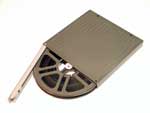7. STORAGE PREPARATION
7.1 CORES
7.2 SUPER/8MM
7.3 CANS & BOXES
7.4 LEADER
7.5 LABELING
Preparation
for storage means that the film is packaged using archival materials
for internal protection, and is structurally protected from the
outside environment. Archival cans and cores made of an inert plastic
that will not chemically react with the film. Archival metal cans
are coated with an inert coating that is additionally rustproof.
back
to top
7.1
CORES
For 16mm and 35mm, it is better to store your film wound on cores
than on reels, as reels can rust, bend or break and damage your
film. 3" diameter cores are preferable to 2" cores, since
the wind of the film at the core is not as tight, and not as prone to curling. You
will need a split-reel a
film at the core is not as tight, and not as prone to curling. You
will need a split-reel a nd
a rewind bench in order to use cores. The wind should be of an even
tension - not too loose or too tight and should be consistent and
flat so that edges don't stick out where they could be broken. A
roll of film on a core should be wound tight enough so that it forms
a solid disc. Be careful not to "pop" the core (detach
the inner core from the outer roll of film), as this will result
in a spiral mess of film. It is preferable to not handle the film
at all, but instead to use either cans or split reels as platters
to hold the disk of film. Before you put your important film on
a core, practice a number of times with some junk film. Film on
cores can be tough to handle, and you don’t want to find out
the hard way that you needed more practice. nd
a rewind bench in order to use cores. The wind should be of an even
tension - not too loose or too tight and should be consistent and
flat so that edges don't stick out where they could be broken. A
roll of film on a core should be wound tight enough so that it forms
a solid disc. Be careful not to "pop" the core (detach
the inner core from the outer roll of film), as this will result
in a spiral mess of film. It is preferable to not handle the film
at all, but instead to use either cans or split reels as platters
to hold the disk of film. Before you put your important film on
a core, practice a number of times with some junk film. Film on
cores can be tough to handle, and you don’t want to find out
the hard way that you needed more practice.

If the film
is one you will be accessing fairly often, you may wish to leave
it on a reel. Make sure the wind is consistent and flat, so the
edges will not be broken or bent. Make sure the reel is in perfect
condition, not rusty, broken, or bent.
back
to top
7.2
SUPER/8
Although there is no chemical or physical difference between 8mm/Super
8 and other film gauges, its smaller size gives it some storage
problems of its own. Some archives make their own 8mm cores by using
a band saw to slice 35mm cores. Because 8mm cores are so difficult
to handle, however, it is a better idea to leave 8mm film on plastic
reels. If you only have the original 50 ft. reels you should consider
splicin g
them together onto larger reels for storage. There are several sizes
of Super/8mm reels; 200 ft. and 400 ft. reels are recommended. The
smaller the hub (solid center) of the storage reel, the more likely
it is that the film will become curled. If you do build up several
reels, be sure to either keep the original boxes or copy down any
information that might have been written on them. Keep this information
with the newly created reel. Also, you should splice leader between
reels, labeling what each one is. Don’t use audiotape reels
because they tend to be styrene, which is not stable for long-term
storage. They are also generally not usable for projection. g
them together onto larger reels for storage. There are several sizes
of Super/8mm reels; 200 ft. and 400 ft. reels are recommended. The
smaller the hub (solid center) of the storage reel, the more likely
it is that the film will become curled. If you do build up several
reels, be sure to either keep the original boxes or copy down any
information that might have been written on them. Keep this information
with the newly created reel. Also, you should splice leader between
reels, labeling what each one is. Don’t use audiotape reels
because they tend to be styrene, which is not stable for long-term
storage. They are also generally not usable for projection.
back
to top
7.3
CANS & BOXES
The film should be stored in clean archival plastic, archivally
treated metal cans, or new archival cardboard boxes. It is important
that the can or box is not airtight, and should not be sealed unless
stored in freezer. A closed can is fine, and will not be airtight.
However, a can that is taped shut is not fine. Cold storage is the
best for the chemical stability of the film and is discussed in
the following sections. Films should be stored tails-out so you
will have to rewind them before projecting. You should always inspect
the film before projecting.
The cans should
be stored flat (horizontally), with nothing heavy stacked on top
that would weigh down the lids and not allow air to circulate into
the cans. It is acceptable to stack the cans on each other, but
store nitrate cans only 2 high.
back
to top
7.4
LEADER
Dirty or damaged leaders should be removed and replaced.
Plastic leader tends to shrink at a different rate than acetate
film, so it is advisable to purchase acetate or polyester leader
from FPC, a Kodak company. Be sure that both the head and the tail
of the film have enough leader to wrap around the reel several times.
This will protect it during storage, as well as during projection.
The majority of the damage done to projected films occurs at the
beginning and ends of reels.
back
to top
7.5
LABELING
Labeling your film is very important. Each reel of each
film needs to be labeled (on the leader) with the title, reel number,
and whether it’s positive, negative, camera original, track
only, etc. It is also a good idea to label leaders "HEAD" or "TAIL."
also a good idea to label leaders "HEAD" or "TAIL."
 Use
archivally inked pens, which are available at art supply stores,
and make sure you pick one that won’t rub off. If your film
has special concerns (hand painted, for instance), note this on
the film leader as well. Needless to say, the cans or boxes the
film is stored in should also be labeled. It is always a good idea
to label every film container and to document every change you make
to a film. Keep track of what you have and where it is. A simple
list (typed or on a computer) will come in handy. Retain paperwork
that goes with your films (timing sheets, etc.). A coherent labeling
system will be of benefit to anyone who comes into contact with
your film, including you, labs, archivists, and later generations
who inherit your film. Use
archivally inked pens, which are available at art supply stores,
and make sure you pick one that won’t rub off. If your film
has special concerns (hand painted, for instance), note this on
the film leader as well. Needless to say, the cans or boxes the
film is stored in should also be labeled. It is always a good idea
to label every film container and to document every change you make
to a film. Keep track of what you have and where it is. A simple
list (typed or on a computer) will come in handy. Retain paperwork
that goes with your films (timing sheets, etc.). A coherent labeling
system will be of benefit to anyone who comes into contact with
your film, including you, labs, archivists, and later generations
who inherit your film.
back
to top |